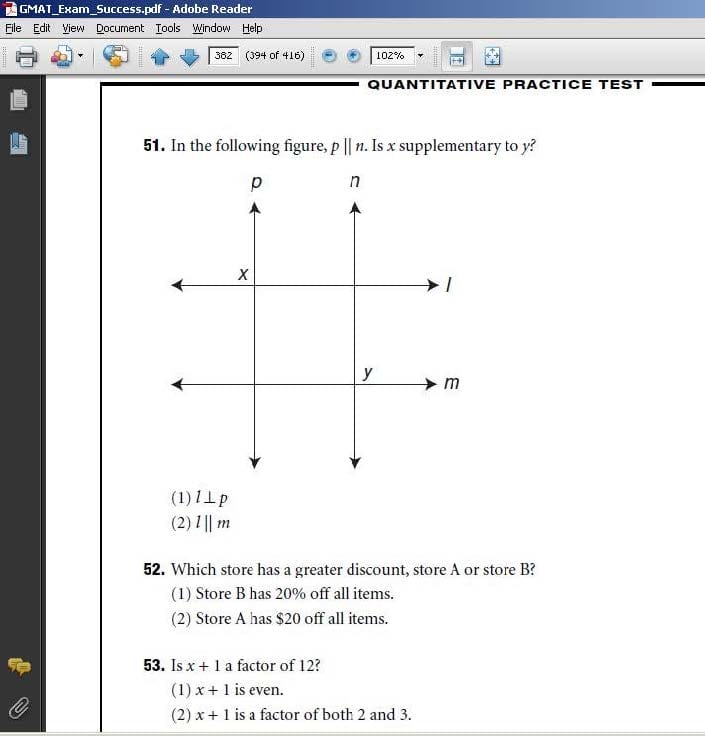GMAT-QUANTITIVE Online Practice Questions and Answers
If it takes Steve 6 hours to tile a floor and Cheryl 4 hours to tile the same floor, how long would it take both Steve and Cheryl to tile the floor if they worked together?
A. 2 hours 12 minutes
B. 2 hours 24 minutes
C. 3 hours
D. 3 hours 12 minutes
E. 10 hours
In orange county one fifth of the people are gathering mushrooms and one seventh of the people are collecting apples. What can be the number of people in Orange County?
A. 60.
B. 42.
C. 85.
D. 140.
E. 252.
If (A+B) = 4, (B+C) = 9 and (C+D) = 3, what is the value of (A+D)?
A. 16.
B. 2.
C. 7.
D. -2.
E. 8.
In a Greek restaurant there is a custom to break plates during celebrations. If after 8 celebrations there were only 6 plates left, which of the following could be the original number of plates before the celebrations?
A. 30.
B. 32.
C. 34.
D. 36.
E. 40.
If X2=Y and Y=4.5X+2.5, which of the following could be the value of y?
A. 25.
B. -0.5.
C. 5.
D. 10.
E. 15.5.
In the following figure, p || n. Is x supplementary to y?

(1)
l p
(2)
l || m
A.
Statement (1), BY ITSELF, will suffice to solve the problem, but NOT statement (2) by itself.
B.
Statement (2), BY ITSELF, will suffice to solve the problem, but NOT statement (1) by itself.
C.
The problem can be solved using statement (1) and statement (2) TOGETHER, but not ONLY statement (1) or statement (2).
D.
The problem can be solved using EITHER statement (1) only or statement (2) only.
E.
The problem CANNOT be solved using statement (1) and statement (2) TOGETHER.
How long exactly did it take Claudia to drive from the beach house to her green house?
(1)
Claudia drove at a constant speed of 55 miles per hour.
(2)
The approximate distance between the beach house and the green house is 200 miles.
A.
Statement (1) BY ITSELF is sufficient to answer the question, but statement (2) by itself is not.
B.
Statement (2) BY ITSELF is sufficient to answer the question, but statement (1) by itself is not.
C.
Statements (1) and (2) TAKEN TOGETHER are sufficient to answer the question, even though NEITHER statement BY ITSELF is sufficient.
D.
Either statement BY ITSELF is sufficient to answer the question.
E.
Statements (1) and (2) TAKEN TOGETHER are NOT sufficient to answer the question, requiring more data pertaining to the problem.
How many days will it take two windows cleaners to clean the entire 30 stories building?
(1)
The first window cleaner can clean 15 windows in 10 minutes.
(2)
The second window cleaner can clean twice as much as the first cleaner in 15 minutes.
A.
Statement (1) BY ITSELF is sufficient to answer the question, but statement (2) by itself is not.
B.
Statement (2) BY ITSELF is sufficient to answer the question, but statement (1) by itself is not.
C.
Statements (1) and (2) TAKEN TOGETHER are sufficient to answer the question, even though NEITHER statement BY ITSELF is sufficient.
D.
Either statement BY ITSELF is sufficient to answer the question.
E.
Statements (1) and (2) TAKEN TOGETHER are NOT sufficient to answer the question, requiring more data pertaining to the problem.
What percent of the employees In X Company are managerial employees?
(1)
30% of the employees are technical.
(2)
There are exactly 45 clerical employees in the X Company.
A.
Statement (1) BY ITSELF is sufficient to answer the question, but statement (2) by itself is not.
B.
Statement (2) BY ITSELF is sufficient to answer the question, but statement (1) by itself is not.
C.
Statements (1) and (2) TAKEN TOGETHER are sufficient to answer the question, even though NEITHER statement BY ITSELF is sufficient.
D.
Either statement BY ITSELF is sufficient to answer the question.
E.
Statements (1) and (2) TAKEN TOGETHER are NOT sufficient to answer the question, requiring more data pertaining to the problem.
Is Y/X odd?
(1)
Y is a prime number.
(2)
X is a prime number.
A.
Statement (1) BY ITSELF is sufficient to answer the question, but statement (2) by itself is not.
B.
Statement (2) BY ITSELF is sufficient to answer the question, but statement (1) by itself is not.
C.
Statements (1) and (2) TAKEN TOGETHER are sufficient to answer the question, even though NEITHER statement BY ITSELF is sufficient.
D.
Either statement BY ITSELF is sufficient to answer the question.
E.
Statements (1) and (2) TAKEN TOGETHER are NOT sufficient to answer the question, requiring more data pertaining to the problem.
